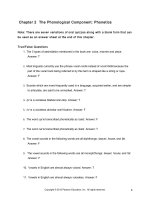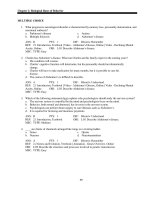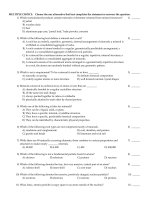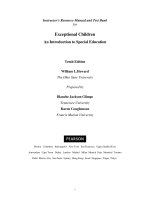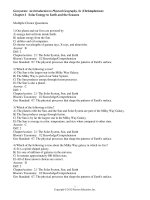Introduction to forensic psychology 3rd edition shipley test bank
Bạn đang xem bản rút gọn của tài liệu. Xem và tải ngay bản đầy đủ của tài liệu tại đây (34.43 KB, 3 trang )
Chapter 2 Review
Questions
1. Which of the following is NOT a reason for which a juror may be challenged for cause:
A. They do not meet minimal juror requirements
B. They are incapable of being impartial
C. They have a mental or physical disability that leaves them incapable of serving
D. They have seen a newspaper article about the case
2. Pretrial publicity has been found to have no effect on jurors.
True False
3. Discuss your views about the CSI effect hypothesis presented in this chapter. Do you believe
that jurors expect too much from forensic science?
4. Areas of forensic psychology practice that frequently require expert testimony are:
A. Competency to stand trial
B. Mental state at the time of the offense
C. Assessment of violence risk
D. All of the above
5. A psychologist is automatically qualified as an expert witness on the basis of his/her training
and education.
True False
6. Do you believe that psychologists should be allowed to testify regarding the ultimate issue?
Why or why not?
7. Discuss the Frye and Daubert standards and how they might affect the admissibility of
psychological evidence.
8. Expert testimony does not influence the jury’s verdict.
True False
9. The 2002 Supreme Court case Penry v. Lynaugh resulted in the mentally retarded being
exempt from the death penalty.
True False
10. The phenomenon in which IQ scores tend to increase at a rate of roughly .3 points per year
following the norming process is known as the ______________.
A. Flynn Effect
B. Maturation Effect
C. Education Effect
D. Obsolescence Effect
11. Discuss the use of strict cutoff scores in the evaluation of mental retardation for capital
cases. Are you in favor of them or not? Debate your position.
12. A forensic consultant conducting a mitigation evaluation must include only information
supportive of a lesser sentence or reduced culpability, in order to fulfill their ethical obligation to protect the defendant from potentially harmful effects from the evaluation.
True False
13. Which of the following would NOT be considered a mitigating factor?
4
Chapter 2 Review 5
Chapter 2 Reviewecont’d
A. A defendant’s history of sexual abuse as a child
B. A defendant’s lack of criminal history
C. A defendant’s behavior during current and any previous incarcerations
D. All of the above are potentially mitigating
14. Describe the “door opening effect” which may occur as a result of the mitigation evaluation, and the considerations an evaluator must address regarding this issue.
Answer Key
1. D. They have seen a newspaper article about the case
2. False
3. Pros of CSI effect: protects defendants from being potentially wrongly convicted on
circumstantial or otherwise inconclusive evidence; allows jurors to determine on a case-bycase basis what constitutes “reasonable doubt.” Cons of CSI effect: defendants who are
guilty may be acquitted due to the presence of only circumstantial evidence; may place
pressure on scientific experts to overstate their findings; jurors may place too much
emphasis on errors associated with scientific evidence to the neglect of other forms of
evidence which may correctly point to a defendant’s guilt.
4. D. All of the above
5. False
6. Pros of ultimate issue testimony: jurors and/or judges do not have to integrate complex and
technical findings without the benefit of an expert’s opinion regarding the issue at hand;
there is some empirical evidence that jurors and judges prefer experts to state opinions
regarding the ultimate issue. Cons of ultimate issue testimony: jurors or judges may go along
with the ultimate issue testimony without critically thinking about the flaws of the expert’s
opinion due to reliance on the opinion of the expert; causes the expert, who is supposed to
be objective and impartial, to take on some aspects of the role of the trier of fact.
7. According to the ruling from Daubert, judges may consider the following factors when
determining whether scientific evidence is admissible: (1) Has the technique been tested in
actual field conditions? (2) Has the technique been subject to peer review and publication?
(3) What is the known or potential rate of error? (4) Do standards exist for control of the
technique’s operation? (5) Has the technique been generally accepted within the relevant
scientific community? In the Frye ruling, it was held that techniques should be generally
accepted by the corresponding scientific community. These standards may affect the
admissibility of psychological evidence in many ways. For example, methodologies and
techniques used in social sciences such as psychology may be less apt to meet the criteria for
Daubert, particularly criteria 1 and 2, than other sciences. Additionally, the general
acceptance standard contained in both decisions may be difficult to prove or meet with
psychological evidence, as there is frequent controversy regarding the appropriate application of psychological techniques, and what constitutes “general acceptance” is subjective
and left open to interpretation.
8. False
9. False
10. A. Flynn Effect
6
Chapter 2 Review
Chapter 2 Reviewecont’d
11. Pros of strict cutoff scores: creates a clear dividing line for what constitutes mental retardation and what does not; may be viewed as more consistent with DSM-IV-TR definition of
mental retardation. Cons of strict cutoff scores: a person may meet criteria for mental
retardation when the confidence interval is considered but their full score may disqualify
them from legal protections in states with strict cutoff scores; this method may not address
what is to be done when a defendant has been tested multiple times and has scores which
fall both above and below the strict cutoff score; some states with strict cutoff scores also
mandate which assessments must be given and when (and sometimes by multiple examiners in a short period of time) e this could create problems with accuracy of testing due to
practice effects and/or test-retest differences.
12. False
13. D. All of the above are potentially mitigating
14. Depending on jurisdictional regulations, discussing a defendant’s actions during an alleged
offense may open the door for prosecutors to discuss the alleged offense with the defendant
as well. Therefore, it is recommended that the expert discuss this matter in detail with
defense counsel prior to asking a defendant any questions regarding the alleged offense,
and it is also noted that often, mitigating evidence may be collected without discussing the
defendant’s actions during the alleged offense, and therefore, these issues may be avoided
altogether. If a decision is made to discuss the alleged offense in detail, the following pros
and cons must be weighed carefully by the evaluator and defense counsel. Having such
a discussion supports the evaluator’s need to have a full, balanced, and comprehensive
dataset from which to form opinions; also, having such a discussion may be necessary to
determine the level of involvement a particular defendant had in a crime, or to ascertain the
level of maturity displayed by a defendant. Failure to discuss the offense with the defendant
leaves one vulnerable to attack by the prosecutor. On the contrary, Cunningham and Reidy
(2001) have suggested that any information necessary to form such opinions may be
obtained from investigative materials. Finally, these authors also contend that the defendant may give a version of events which is not supported by available evidence, and such
information may be unduly damaging when presented to a jury. All of these factors, in
addition to the specific laws and standards for the jurisdiction in which the evaluation
occurs, should be considered by the expert conducting mitigation evaluations when
determining whether or not to discuss the alleged offense with an evaluee.





